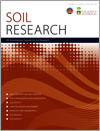SR19075Potential microbial remediation of pyrene polluted soil: the role of biochar
 , Anna Daniela Malerba, Giuseppe Natale Mezzapesa, Stefano Dumontet, Donato Mondelli, Teodoro Miano and Giovanni Luigi Bruno
, Anna Daniela Malerba, Giuseppe Natale Mezzapesa, Stefano Dumontet, Donato Mondelli, Teodoro Miano and Giovanni Luigi Bruno
Polycyclic aromatic hydrocarbons are a large group of toxic pollutants largely produced by anthropogenic activities and characterised by high human toxicity. We studied the effects of biochar, a solid carbonaceous material produced by pyrolysis of plant biomass, as a growth promoter of autochthonous and allochthon microorganisms in soil artificially polluted with pyrene, in order to stimulate bioremediation. Biochar stimulated microbial growth without promoting degrading activity of autochthonous and allochthon microorganisms.




